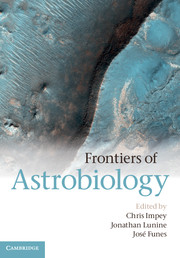Book contents
- Frontmatter
- Contents
- List of contributors
- Part I Introduction
- Part II Origin of Planets and Life
- 2 Towards a Theory of Life
- 3 Terran Metabolism
- 4 Planet Formation
- Part III History of Life on Earth
- Part IV Habitability of the Solar System
- Part V Exoplanets and Life in the Galaxy
- Index
- Plate Section
- References
4 - Planet Formation
from Part II - Origin of Planets and Life
Published online by Cambridge University Press: 05 December 2012
- Frontmatter
- Contents
- List of contributors
- Part I Introduction
- Part II Origin of Planets and Life
- 2 Towards a Theory of Life
- 3 Terran Metabolism
- 4 Planet Formation
- Part III History of Life on Earth
- Part IV Habitability of the Solar System
- Part V Exoplanets and Life in the Galaxy
- Index
- Plate Section
- References
Summary
Introduction
Statistically speaking, one new star is born in our Milky Way Galaxy each year. This star will typically form in the densest parts of the Galaxy, either close to the central bulge or in the spiral arms. This is where giant clouds of cold molecular gas are concentrated, and these are the birthplaces of stars. Within such a cloud, the star forms when a small parcel of gas starts to “feel” its own gravity and begins a slow but accelerating inward collapse. It is not known whether an external trigger – such as shock waves from a nearby supernova – is needed to start this collapse, but once the collapse begins it follows a well-charted path. The angular momentum of the initial parcel of gas causes a disk to spin out as the gas contracts, and it is through this disk that gas is funneled onto the growing proto-star at the center. On a time-scale of 105 years, the central object reaches a large enough mass to increase its internal pressure and temperature above the critical value for nuclear fusion of hydrogen into helium and a star is truly born. An evolving disk of gas and dust orbits the star. This is where planets form.
The Hubble Space Telescope has taken exquisite images of nearby star-forming regions, some of which are, in cosmic terms, right next door. The Orion Nebula – found by Orion's sword in the constellation – is one of the most famous. Although it is more than a thousand light-years away, it is large and bright enough to be visible by eye. Within the Orion Nebula and in other star-forming regions, Hubble has imaged young stars and their dusty proto-planetary disks (O’Dell and Wen 1994). The disks themselves are far too small to be resolved in detail, but they confirm our basic picture: stars form in molecular clouds, and planets form in disks that are ubiquitous around young stars.
- Type
- Chapter
- Information
- Frontiers of Astrobiology , pp. 73 - 86Publisher: Cambridge University PressPrint publication year: 2012



